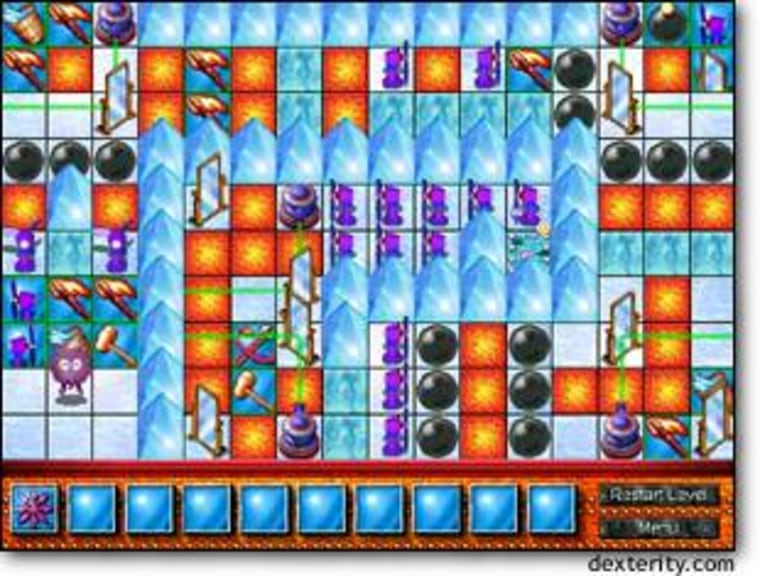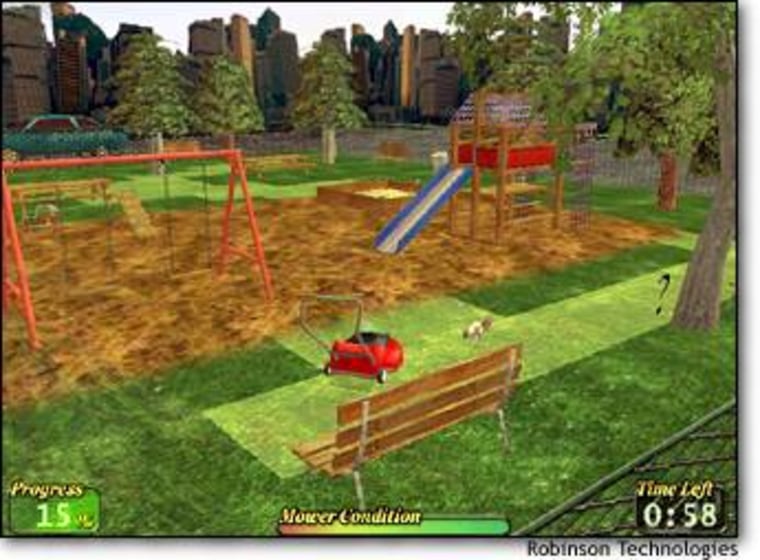A deadly green protoplasm undergoes mitosis at a horrific pace. Your mission: Punish the invading ooze with withering fire from your micro-gun. The game play is addictive. The soundtrack is awful, but in that self-aware “we know we’re being cheesy” sort of way. As for the graphics ... well, it looks like a blob.
Independent computer gaming. It’s not always pretty, but ask any one in the biz and they’ll say that it represents the purest form of game development. And sometimes the cheapest. A check for ten bucks sent to a site called Cheap Ass Games buys you “Dr. Blob’s Organism.”
And because indie gaming lies outside of the publisher money train — and all the corporate pressures to follow trends — it often delivers some of the most creative PC games available to an audience far beyond your typical 19-year-old gamer.
Cheap ... cutting edge ... a different audience ... are indie games the punk rock of computer gaming?
Innovation on a budget
Geoff Howland, a full time UNIX administrator, devotes his free time to his company Alitius. With Alitius’s employee population running at one — Howland, himself — the chances of creating a game with the big budget and killer graphics of a typical retail title are zilch. But Alitius’s garage-like business philosophy in an industry of manicured office parks is not a cause for complaint, but an incentive for creativity.
“In retail, there are about five or six different genres. No one is doing anything different,” said Howland. “Whereas independents can and should concentrate on that difference.”
His game, “BaseGolf,” is a coffee-break friendly diversion that combines aspects of, yes, baseball and golf. But the “difference” cited by Howland extends beyond sports hybrids. In indie gaming, it can include new story-lines, audiences and game play.
“Teenage Lawnmower,” from Robinson Technology, a Japan-based husband and wife team, plays like a Gen Y afterschool special, with an alcoholic mother, an abusive boyfriend and a lawnmower gig.
Battlefront.com recreates World War II-era armored battles for the serious military gamer, a niche market. Dexterity Software does the opposite; reaching a mass audience with puzzle games. Both of these indie developers target audiences that retail games can’t or won’t reach.
For game developer Egenesis the difference lies in turning the massively multiplayer online game on its head. “A Tale in the Desert” ignores dragons and orcs for game play geared toward constructing an almost utopian society. Players accumulate power not through combat, but through mentoring and acts of leadership.
Mentoring? Radical.
Who are the indies?
Games hatched beyond the pale of the corporate development is not new. On the contrary, it’s where game development was born. Yet while computer gaming goes Hollywood with all its giant E3 tradeshows and movie stars plugging console games, a steady stream of talented programmers is making independent games — traditionally an idea incubator of sorts — a continually fascinating subculture of computer gaming.
“These developers are really returning to the way PC game development was in the late 80’s and early ’90s before it became so corporate,” said indie game evangelist James Hills. “Doing it because they love games and have a passion for creating the visions they have in their heads.”
The approximately 1,500 teams and individuals involved with indie development are as diverse as the games themselves. Some are in the business to make it big by selling their title or talent to a major game publisher. Others, including an ever-increasing number of developers with experience in larger companies, cherish the freedom of doing what they please.
“I see a lot more people with really solid, big game development making the leap,” said David Nixon, executive producer at RealOneArcade, an online game portal. “It’s why they got into game development in the first place.”
Dexterity president Steve Pavlina once worked in commercial game development. “With game budgets larger and teams larger, developers can feel like a cog in the machine,” he said. “They feel like there is no room for creativity. So yes, there’s a move to go back to the roots.”
Fighting for online shelf space
Most indie game development studios are small, low budget operations.
“Some companies are in a position to spend money, but often titles are produced with little or no budget,” said Steve Verreault of Twilight Games. “It’s a couple guys who may contract out an artist or musician.”
Budgets vary — from zero to $100,000 for a title — as do sales. Game studios like PopCap and GameHouse may take in over a million in revenue a year. A typical three-person indie studio may make barely enough to cover costs.
Online transactions promised a revolution of sorts for indie companies, who previously relied on customers to send a check in the mail. But getting heard above the increasing online noise is a problem.
“It’s not unusual for someone to spend a few thousand dollars getting the word out,” said Verreault.
Free trials, available from a studio’s Web site, download sites like Download.com and Tucows and game portal sites like RealOneArcade and MSN’s Zone.com are at the center of an indie’s marketing strategy.
Honing gameplay to the medium
“There are certain attributes in ‘try before you buy,’” said David Nixon, the executive producer of RealOneArcade. “They have to be a small download. They have to be understood easily. They have to get you hooked right away.”
Cheap to create, easy to understand and download friendly, puzzle and card games have grown to become the two most popular genres within independent gaming.
“It’s like an arcade game where you have a limited amount of time to get them interested,” said Jason Kapalka of PopCap Games. “And working within the limitations of form is a challenge but interesting.”
No indie game company has nailed the formula better than PopCap, creator of “Bejeweled” and “Bookworm” — two of the hottest puzzle games available. The 20-person company has sold 10 million games since 2000.
“We’re aiming to get people who don’t play computer games to play games,” said Kapalka. “If I can put my mom down in front of the game and [she can] actually play it, then I know it can work.”
PopCap and the online game portals have helped open up computer gaming to soccer moms worldwide. Popcap says that its average user is a 35-year-old women. RealOneArcade claims that over 50 percent of its audience is female and 85 percent over the age of 30.
“Our customers are playing to relax and unwind from the day to day grind. They don’t want to be reminded that they’re idiots or lack hand-eye coordination,” Nixon explained.

BACK TO THE GARAGE
Puzzle and card games may introduce a larger audience to computer games, but they take innovation only so far. Already, said both Kapalka and Nixon, the market is glutted with new puzzle games from upstart indies.
So what’s next?
Jeff Tunnel is the president of Garage Games, an indie game publishing company that also licenses its game engine to indie developers for $100. The engine is the software that makes a game look the way it does. Its code handles rendering as well as such tasks as AI and collision detection.
“The tools and technologies are getting better,” Tunnel said. “The conventional wisdom is that it takes $10 million and 20 guys to make a game. That’s not true. A few guys in a garage can create a great game.”
A decade ago, a group of independent developers unleashed “Doom.” It changed PC gaming forever and reaffirmed the fact that talented individuals often work best outside the corporate mainstream.
Somewhere out there amongst the garages, dorm rooms and cluttered apartments may lie the code for the next “Doom.” When Geoff Howland drives home from his day job, he poses a question to himself: What can an indie with no budget do to attract attention? “From my perspective I’m trying to do something unique. It should pose a question. What is this? My response is try it, you might like it.”
When not babbling about computer games, Tom Loftus produced interactives for MSNBC.com
